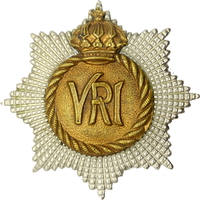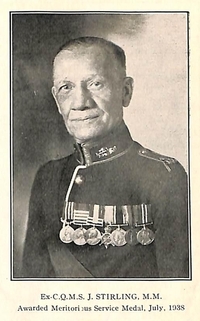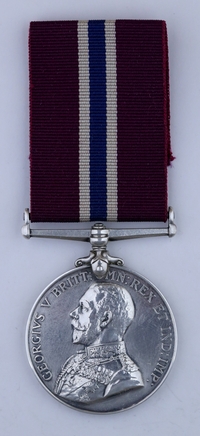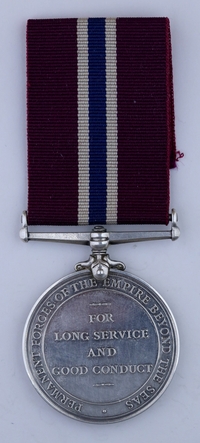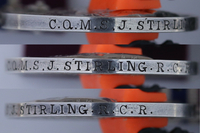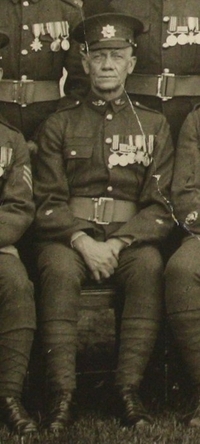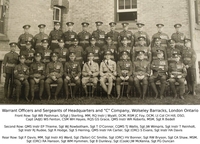
9595 / 477887 / 12016 C.Q.M.S. John "Jock" Stirling, M.M.
The Royal Canadian Regiment
By: Capt (ret'd) Michael M. O'Leary, CD, The RCR
John Stirling was born in Glasgow, Lanarkshire, Scotland, on 1 Aug 1873. He was the son of James Stirling, of 44 Preston St., Govan Hill, Glasgow, Scotland.
Stirling enlisted for service in the Canadian Permanent Force with The Royal Canadian Regiment at Halifax, N.S., on 27 Feb 1912. He claimed to be 28 years 6 months of age (effectively reducing his age by a decade). During his medical examination, his apparent age was noted as 39. Stirling was pronounced fit to serve, except that his "teeth required attention before final approval."
On his attestation form, Stirling stated that he had served for 10 years, 297 days, in the Royal Artillery. An entry in a later document in his service record confirms that he had been awarded the Queen's South Africa medal with four clasps (Modder River, Paardeberg, Driefontein, and Transvaaal) and the King's South Africa medal with two clasps (South Africa 1901, and South Africa 1902). On joining The RCR Stirling was assigned the regimental number, 9595.
On 18 Jul 1912, Stirling was appointed Lance Corporal (unpaid). He would later be granted the matching pay.
The Royal Canadian Regiment sailed for Bermuda on 11 Sep 1914. Arriving at Bermuda, the Regiment relieved the 2nd Battalion, Lincolnshire Regiment, which sailed immediately for England.
While serving in Bermuda, Stirling was promoted Corporal on 1 Nov 1913 and assigned to "D" Company from RHQ. At the end of his first three-year engagement, he would re-engage for continuing service with The RCR on 27 Feb 1915.
On 12 Aug 1915, The RCR was relieved of its duties in Bermuda by the arrival of the 38th Overseas Battalion from Canada. The Regiment returned to Halifax for a stay of only a week during which the Regiment was re-attested for overseas service. Although The RCR had just spent a year in Bermuda, there were concerns regarding the applicability of the soldiers' Permanent Force enlistments for wartime deployments. This was, perhaps, prompted by the idea that a man on a P.F. three-year engagement could choose not to re-engage and the Government would be obligated to bring him home. Enlistment in the C.E.F., on the other hand, was for the "Duration of War" whether or not a man's Permanent Force engagement lapsed. Accordingly, the soldiers of The RCR were re-attested, signing C.E.F. attestation papers in August 1915 before sailing for Europe.
While in Halifax, Stirling was charged and found guilty of being absent from parade on 20 Aug 1915. For his crime, he received a Severe Reprimand, but did not lose his rank.
Stirling attested for service in the Canadian Expeditionary Force (C.E.F.) with The RCR at Halifax, N.S., on 23 Aug 1915. A 42-year-old professional soldier with a prior trade of engineer (locomotive fitter), Stirling was described on his attestation paper as 5 feet 6 3/4-inches tall, weighing 170 pounds, with a 38-inch chest, a dark complexion, brown eyes, and brown hair. His religious denomination was Presbyterian. Stirling identified his sister, Miss J. Sterling, 44 Preston St., Govanhall, Glasgow, Scotland, as his next of kin. On his attestation form, Stirling claimed previous service of 10 years 29 days in the British Army.
The RCR sailed from Halifax aboard the S.S. Caledonian on 26 Aug 1915. This was the same ship that had brought them home from Bermuda. Disembarking at Plymouth, England, on 6 Sep 1915, the Regiment went to Shorncliffe for training.
On 28 Sep 1915, Stirling would receive a new C.E.F. service number to replace the regimental number he received on enlisting. While serving in the C.E.F., his service number would be 477887. Since the Regiment received its C.E.F. numbers while at full strength and not as they were recruited, it had the interesting effect that the soldiers of the Regiment at the time were renumbered in alphabetical order.
After two months in England, The RCR crossed the English Channel on 1 Nov 1915, entering the theatre of war at Boulogne, France. During November and December of 1915 the Regiment prepared for service in the trenches, with companies rotating in the lines for training and a period of providing working parties before entering the line as a battalion at the end of December. The first months of 1916 saw the Regiment in the steady rotation through front line trenches, support trenches, and reserve positions that was the fundamental experience of the infantry in the Great War.
On the night of 21 Apr 1916, The RCR was relieved in the front line trenches by the 43rd Battalion and moved into Divisional Reserve. The Regiment occupied huts at Camp "E" midway between Poperinge and Ypres, near Brandhoek, Belgium. On the third day in huts, disaster struck. After two days of War Diary entries simply stating "NIL," the entry for 24 Apr 1916 was direct and to the point:
"At about 4.00 a.m. a Hostile aircraft drops 3 Bombs on Camp "E" occupied by R.C.R. One Bomb making a direct hit on one of the huts inflicting casualties to the extent of Killed 3 O.R. Wounded 31 O.R."
Seven more men would die of their wounds from the bombing. Cpl. John Stirling was admitted to No. 24 Casualty Clearing Station (C.C.S.) suffering from multiple shell wounds. Although his wounds were considered "slight," he was was transferred via No. 3 Ambulance Train and admitted to No. 3 Canadian General Hospital, Boulogne.
Three weeks after the bombing of the Camp "E" huts, Stirling was admitted to No. 2 Convalescent Depot on 14 May 1916. Two days later he was transferred to No. 1 Convalescent Depot, Boulogne, and discharged to Base Details. He rejoined the Regiment in the field on 28 May 1916.
The RCR was in Brigade Reserve from 23 to 29 May 1916. On the last day of that period, The War Diary reports the arrival of Stirling and six others from the Base Hospital along with another 43 reinforcements. The next day, the Regiment relieved the 42nd Canadian Infantry Battalion.
The Regiment's War Diary for 30 May 1916 describes the conditions in the trenches:
"Weather wet, cleared up towards evening. R.C.R. Relieved 42nd Can Battalion in HOOGE Section, … Relief completed 12.45 a.m. 31.5.16. Situation quiet. Men did not take their packs into trenches owing to the cramped conditions. This Section is in the most battered condition of any the Regiment has yet been in. Front line is a succession of Posts, some partially connected and other not connected at all. Wounded cannot be taken out of front line or Reserve line in the daytime."
For Stirling, this tour of the front line trenches would last two days. On 1 Jun 1916, during a day the War Diary reported as "Situation quiet," he was admitted to No. 10 Canadian Field Ambulance, transferred to No. 10 C.C.S., and then evacuated to No. 3 Canadian General Hospital, Marlborough, Boulogne. His wound was noted as "G.S.W., back, slight." G.S.W., or gun shot wound, was a term applied to wounds cause by bullet, shrapnel, or shell splinters.
Stirling remained in hospital until 19 Aug 1916, when he was transferred to No. 7 Convalescent Depot, Boulogne. A few days later, on 22 Aug 1916, he was discharged to a Rest Camp at Boulogne and soon after taken on the strength of the Canadian Base Depot (C.B.D.). Stirling return to the Regiment in the field on 10 Oct 1916 as the Regiment concluded its contribution to the battle at Regina Trench and commenced eight days of marches to the La Folie area.
Through the winter of 1916-17 and early spring of 1917, the Regiment followed the cycle of forward trenches, support trenches, and reserve positions that would characterize the infantry experience of the Great War. Between late October, 1916, and February, 1917, the Regiment would occupy forward trenches eleven times, each rotation lasting about four days between relief operations.
After months of preparations, the Canadian Corps executed the successful assault on Vimy Ridge on 9 and 10 April 1917. The excellent work of many members of the Regiment, including Stirling, is recorded in the regimental history of The RCR (Fetherstonhaugh, 1936):
"Having reported these losses [seven officers and 50 other ranks killed or fatally wounded, 65 other ranks missing and five officers and 150 other ranks wounded], Lieut.-Col. Hill proceeded with the more agreeable duty of reporting on the devotion with which his men had carried out the duties assigned to them. In this respect he noted the services rendered by Major C.R.E. Willets, Lieut. R. England, Lieut. T.S. Allan, Lieut. A.G. Stride, who, upon Lieut. Churchill becoming a casualty, had succeeded to the command of "D" Coy., and Lieut. A.A. Allenback, who, after the fatal wounding of Capt. Munn, had led'"A" Coy. to its final objective. In addition to' these officers, Lieut.-Col. Hill reported the outstanding services of Sergt. E.M. Ross, M.M., who for a time had commanded "B" Coy.; Sergt. A.E. Dockrill, whose work in the front line was "magnificent"; Sergt. J. W. Howard, whose gallantry in La Folie Wood was conspicuous; Corporal J. Stirling, who held an isolated position in La Folie Wood with courage and determination; Sergt. W. Stewart, who, though wounded over the heart, led his platoon to its objective and continued to command until he collapsed from loss of blood; Sergt. H. Brealey, who, though twice buried by shell fire at Birkin Dump, was instrumental in rushing supplies forward; Sergt. P.C.S. McCartney, whose work with the Lewis guns in the Final Objective was highly effective; and Sergt. John Connolly, the first man to reach the Final Objective, where he killed a German officer and 4 men who were determinedly opposing the Regiment's assault. Conspicuous gallantry was also reported to have been displayed by Lance-Corporal Neil Nicholson and Privates L. Adams, C. McArthur, J.W. Grimmett, C.A. Imerson, C. Collver, and E.G. Wells."
As the Regiment reorganized and absorbed reinforcements after Vimy Ridge, Stirling was one of those promoted to fill vacancies in the chain of command by the battlefield losses. On 15 Apr 1917, he was promoted to the rank of Sergeant to complete the unit establishment. The following month, he went on leave to the UK commencing 20 May 1917, rejoining the unit on 8 Jun 1917.
On 9 Jul 1917, Stirling's actions at La Folie Wood during the assault on Vimy Ridge were formally recognized. The London Gazette published that date, issue no. 30172, included under honours and awards for Canadian Forces, the gazetting of the Military Medal for "477887 Sjt. J. Stirling, Inf."
The citation for Stirling's Military Medal reads:
"MILITARY MEDAL
"After gaining the Final Objective in the attack on VIMY RIDGE on April 9th 1917, this N.C.O. displayed the greatest gallantry and determination in holding an isolated forward post in LA FOLIE WOODS, thus preventing a surprise counter attack. He reconnoitred the area in advance of our line and personally maintained contact with the main position. He has served continuously with the Regiment in FRANCE since 1st November 1915."
On 15 Sep 1917, Stirling went to the 7th Brigade Training School. His service record does not detail his duties there but it is likely he went as an instructor and remained with the School for over a year. In December, 1917, he commenced a pay assignment to go to his sister Jeannie in Glasgow for $15 per month, which he would continue this until April 1919. His record also shows that he went on 14 days leave to the UK during the first two weeks of November 1918.
Shortly after returning from leave, on 22 Nov 1918, Stirling rejoined The RCR in the field. He was appointed Company Quartermaster Sergeant (C.Q.M.S.) on 6 Jan 1919, replacing 477606 C.Q.M.S. Morrison who reverted to a sergeant's position.
The war over, The RCR spent most of the month of January 1919 at Estaimbourg, Belgium. Daily activities included route marches, drill and the "usual company parades." At the end of January, 324 officers and men proceeded to England for five days leave and would thereafter report to Bramshott. The leave party would get no further that Baiseux, France, less than 10 miles away, before being held up by the effects of striking train workers. The remainder of the Regiment marched to Baiseax on 1 Feb 1919.
The RCR arrived at Havre on the French coast in the early morning hours of 3 Feb 1919. After a day of baths and medical examinations, and a day of preparations before sailing, the unit embarked on the S.S. Mona Queen just after midnight 6 Feb 1919. Disembarked at Weymouth, England, the following day, The RCR proceeded to Bramshott before sailing home.
The Regiment's War Diary summarizes the final month overseas:
"9.2.19. to 28.2.19. – BRAMSHOTT CAMP
"General cleaning up, fitting of equipment, Paid. This period was spent in arrangement of documents. All ranks were medically and dentally boarded and were then sent on 8 days leave. On 28.2.19. the Battalion paraded in full marching order for inspection by the Commanding Officer. The Regimental Colours were then brought on parade and the Battalion marched past them."
On 1 Mar 1919, Stirling proceeded to Canada from Liverpool aboard the S.S. Adriatic. ON sailing, he was struck off strength the Overseas Military Forces of Canada (O.M.F.C.) and officially on the strength of No. 6 District Depot in Halifax, N.S.
On arriving in Halifax on 9 Mar 1919, Stirling's disposition was determined by No. 6 District Depot. He was posted to Disposal Station "B" and immediately transferred to the Base Depot, The RCR. Less than a week later, on 15 Mar 1919, C.Q.M.S. John Stirling was discharged from the C.E.F. on demobilization. He was issued the Class "A" War Service badge, numbered 77351. The following day, he re-enlisted in Permanent Force and was assigned a new regimental number, 12016.
On discharge from the C.E.F., Stirling was eligible to receive a War Service Gratuity of $420. Cheques were issued to him in five installments between April and July 1919.
The regimental history (Fetherstonhaugh, 1936) describes the initial steps in reconstituting the Regiment as a Permanent Force unit:
"On May 2, Capt. W.S. Fenton was appointed Regimental Adjutant, a post which he held for more than four years; and on May 23 progress in the reconstitution of the Permanent Force unit was revealed when garrison duties ceased to appear in Base Depot Daily Orders and were promulgated only in Regimental Daily Orders. The Base Depot continued in operation until August 21, when Capt. Logan and the remaining personnel under his command were absorbed into the main body of the Regiment.
"Meanwhile, despite the fact that all appointments were provisional, Lieut.-Col. Hill had been encouraged by the return to duty of a number of experienced officers and by the recruiting of several of the Regiment's finest N.C.O's. Regimental Sergt.-Major W.R. Roberts joined before the strength had reached one hundred, and soon the roll included Company Sergeant-Majors A.A. Giles, J. Wyatt, D.C.M., J. Woodcock, W.H. Clark, G.F. Turner, and A. Jackson, also Company Quartermaster Sergeants J. Stirling, M.M., and W. J. Rowbotham."
As the Regiment re-occupied pre-War garrisons in Halifax, Montreal, Toronto, and London during 1919 and 1920, Stirling was posted to Wolseley Barracks in London, Ont.
On 5 Aug 1921, Stirling was medically examined and a "Medical History of an Invalid" form completed. At the age of 49, his identification marks and scars included a herniotomy scar on the right side, tattoos of roses on his right forearm, and a tattooed "R.C." on his left forearm. Stirling's next of kin was still his sister in Glasgow and his own residence address was recorded as Tecumseh Barracks at Wolseley Barracks, London. His identified disability was an inguinal hernia (right side) which originated when he fell at Camp Valcartier in August 1920.
Stirling's operation wound had healed well, but he still suffered from feelings of general weakness. He was otherwise in good health except for tertiary syphillis, i.e., late stage complications from that disease. It has been identified from the delayed healing of his hernia wound and, although he showed no outward signs, began treatments for it.
The history of Stirling's condition was recorded as follows:
"In August 1920 at Valcartier Camp tripped and fell, felt sudden and severe pain in lower right side abdomen, noticed swelling, was supplied with truss, this was unsatisfactory, reported sick March 10th 1921, admitted to hospital, operated on March 12th, wound did not heal, and on June 5th patient admitted having had a chancre in 1894 at Aldershot, England, was not told he had Syphilis received no Anti-Neutic treatment. Blood taken June 6th, Wasserman — last Wasserman July 19th — has to date received eight Nitra Nueous injections (New Diarsenal) wound rapidly healed."
Stirling also claimed that he had "Never been ill prior to present time except G.S.W. right foot, Africa 1899. Bullet wound June 1916, shrapnel wound right foot, shoulder, April 1916, France." He was recommended for a further two to three months of convalescence and that he "report on arrival in Scotland (where he was headed on furlough) for further blood examination and treatment if necessary." He was given a medical category of "D" (Temporarily Unfit) and "E" (Unfit for Categories "A", "B", and "C"). Further treatment was continuing Anti-Neutic for an indefinite period. In total, Stirling was off duty for 124 days following the fall and operation.
On 27 Feb 1922, "C" Company and the Band of The RCR marched from Wolseley Barracks to the Dundas Street Armoury in London. Here they conducted a ceremonial parade in commemoration of the Battle of Paardeberg including the trooping of the Banner presented to the Regiment by King Edward VII in recognition of the Regiment's service in the Second South African War. Following the parade, medals were presented by Maj.-Gen. H.A. Panet, C.B., C.M.G., D.S.O. Among those who received medals, C.Q.M.S. J. Stirling was presented with his British War Medal and Victory Medal.
Stirling would have that first issue of his Great War medals for less than a year. On the night of 12 Apr 1923, there was a fire in one of the buildings of Tecumseh Barracks. These barracks buildings had been erected during the Great War and were still in use for single soldiers of the Regiment and as housing for families on the Married Establishment. The fire broke out in the building used to house single soldiers and non-commissioned officers. The alarm was raised at 9.40 p.m. by Bugler Charles Ward as he was preparing to blow "Lights Out."
The single men's quarters burned to the ground, while the available fire-fighting resources applied much of their capacity to preventing the spread of fire to neighbouring buildings. The rapidly spreading fire resulted in narrow escapes for some of the 80 men who lived in the building and the loss of personal effects by all who lived in the building, including John Stirling. Among the regimental losses were the drums of "C" Company's drum corps. Personal losses included medals awarded to soldiers. One newspaper photo shows men searching the building's remains for these in the following days. There was one casualty of the fire, "C" Company's mascot, a terrier named Mickey. Stirling's service record notes the reissue of replacement medals, which were despatched to him at The RCR, London, Ont., on 7 Aug 1923.
Stirling appears once more in the regimental history (Fetherstonhaugh, 1936) when he was one of the pall-bearers at the funeral of the Regiment's long-serving Director of Music:
"Though the period had been marked by notable successes in military accomplishment and in sports, the years had not passed without the Regiment's having suffered the loss of valued comrades, notably on January 22, 1924, when Capt. Michael Ryan, the unit's Director of Music, died at London, Ontario, … Capt. Ryan was a well-known and beloved figure. He had first joined the 3rd (Special Service) Battalion at the time of the South African War and had later served with the Permanent Force and Expeditionary Force battalions in Halifax, Bermuda, France, Montreal, Toronto, Valcartier, and London. When his body was marched to the train in London, the pall-bearers were Lieut.-Col. C.H. Hill, Major A.K. Hemming, Capt. V. Hodson, Capt. W.S. Fenton, Coy. Sergt.-Major F. Davis, Coy. Quartermaster-Sergt. J. Stirling, Staff Sergt. H.V. Bonner, and Sergt. J. Dymond. The firing party was under the command of Capt. R.E. Balders. Halifax, where Capt. Ryan was buried, military honours were paid by "A" Coy., with the firing party under the command of Capt. F. G. Macculloch. Many other officers and men of the Halifax garrison and many former members of the Regiment then in civilian life in Nova Scotia attended, for all realized that Capt. Ryan had contributed greatly for more than twenty years to the success, not only of his own Regiment's band, but for that of many of the finest musical organizations in the Canadian forces."
The Great War added significant dates and place-names to the Regiment's history. As the regimental garrisons adjusted to the routines of garrison life, these included marking the anniversaries of the Regiment's successes and sacrifices. The 10 Apr 1924 edition of The London Advertiser described one social event of the London garrison:
"Anniversary of Vimy Celebrated "Remember Illustrious Dead at R.C.R. Smoker.
"Officers and men of the Royal Canadian Regiment celebrated the Battle of Vimy Ridge at Wolseley Barracks last evening by a regimental smoker in the company mess hall. Comradeship joy reigned for the greater part of the evening as befitted members of a British regiment celebrating a great victory. but at the end of the evening's merrymaking silence deep and reverent reigned for a few moments while the regiment stood with uplifted glasses in a toast to the "Illustrious Dead."
"Major A.K. Hemming, commanding "C" Company, was the senior officer present, as Lt.-Col. Hill, D.S.O. was in Ottawa yesterday where veteran commanders of the late war were guests of Lord Byng, of Vimy, at Rideau Hall.
"Company Sergt.-Major Davies, M.M., of "C" Company, acted as Chairman of the regimental smoker with Q.M.S. J. Stirling acting ae general director of the Vimy Day program.
"Sergt. Johnston, Drummer L. Wilson and Ptes. Bird, W. Comier and Howell-Harris delighted with solos, covering a wide range from martial and sentimental to the broadly comic.
"Happy speeches were made by Major Hemming, Capt. Balders, Capt. Holloway and Capt. Weekes.
"Bandman Proderick gave several pleasing saxophone numbers."
On 9 Feb 1925, a "Report on Wounds or Other Injuries, Except on Wounds Received in Action" was completed on Stirling. Admitted to hospital on this date, he was suffering from a fractured wrists and lacerated scalp wound which were sustained in the performance of military duty. The Commanding Officer's certification, signed by Lieut.-Col. E.A. Seely-Smith, read:
"At Wolseley Barracks, London, Ontario, this warrant officer was removing accumulated ice from a sloping roof over the approaches to the barrack room and men's mess. This ice had become loosened by the sun and was a danger to those passing. In doing so he lost his footing and fell to the pavement below, 9th February, 1925."
On the following day, a Court of Inquiry assembled at Wolseley Barracks by order of the Commanding Officer, Lt.-Col. E.A. Seely-Smith, reached the following conclusion:
"The Court having read and carefully considered the … evidence are of the opinion that C.Q.M.S. J. Stirling, M.M., The R.C.R. sustained severe injuries to both his wrists whilst acting in the best interests of the personnel quartered in barracks, and that these injuries were caused entirely accidentally, and no blame can be attached to him."
Stirling's wrists were examined on 10 Feb 1925. The examination notes included "fracture and splintering of radius and ulna in both wrists, in right wrist there is a marked displacement of lower end of radius to radial side. The left limb shows less displacement. Styloid process in not altogether in line, but do not believe can be much improved."
The severity of the damage to Stirling's wrists is reveled in the medical report from an examination made on 12 Mar 1926. His present disability was noted as "partial loss of function both wrists" and his present condition was recorded:—
"Subjective:— Both wrists painful chiefly in bad weather, cannot do any heavy lifting, has no trouble using typewriter.
"Objective:— Well nourished; cold ruddy; looks his age, all upper teeth removed; artificial plate is worn, lower teeth require dental attention Pharyn injecto. Chest well nourished and developed; clavicle slightly prominent. Resp excursion Fair (well marked Arcus Senitis) Chest Hypersonant throughout Breath sounds rough. Abdomen negative; scar of hernia operation well healed. No limitation of movement of right ankle or difference in measurements."
Despite his disability, Stirling was pronounced fit to continue performing the duties of quartermaster sergeant. He was given a medical category of "B", fit for home service (Canada only).
A note in the regimental journal, The Connecting File (Vol. V, No. 3) of September 1926, recorded the latest addition to Stirling's medal group: "Our congratulations to C.Q.M.S. Stirling on the award of the Long Service and Good Conduct Medal." He received the Permanent Forces of the Empire Beyond the Seas Long Service and Good Conduct Medal.
The following edition of The Connecting File (Vol. V, No. 4), dated December 1926, mentioned Stirling as a team member for the Headquarter's billiard team:
"Headquarters and "C" Company, London, Ont.
"The team entered by Headquarters in the Inter-Military Billiard League, for the Shield, donated by the London Free Press, has finished in third place in the first series, just concluded. The final positions were The Canadian Legion, The T.V.A., The R.C.R., and Westminster Hospital. The exact scores are not available at the time of this edition going to press. In the second series, however, our team has made a great start, for out of three of the four games of the first match, we have a lead of 189 points, and aggregate points reckon.
"The team consists of Serjt. L. Waters, Bandsmen Nicholls, Thomas and Thompson, with C.Q.M.S. Stirling and Corpl. Gillman as spares."
The same issue of The Connecting File including Stirling's name in a list of "Old Comrades": "C.Q.M.S. J. Stirling; M.M., Wolseley Barracks, London, Ontario; serving in "C" Company."
On 14 Jan 1929, Stirling was medically examined and a "Medical Report of an Invalid" was completed. At age 55, he now weighed 122 pounds. Changes recorded from past examinations noted that his wrists were described as "deformities." The injuries from which he continued to feel effects were not his wartime wounds, but the falls he took in 1920 at Valcartier Camp (hernia) and 1925 at Wolseley Barracks (broken wrists). These resulted in partial loss of wrist function, restrictions in choice of future occupations, and impairment of the function of his abdominal wall.
Stirling's present condition was described:—
"Objective:— Man of age stated. General examination negative with exception of the following:— Both wrists show evidence of old fracture with union in poor position. (Orthopaedic and X-Ray reports were noted.) There is a well-marked hernia (Inguinal) on the right side, somewhat difficult to reduce. A scar of a former operation for radical cure is present.
"Subjective:— Complains of both wrists being weak that he cannot lift much of a weight and that the left wrist is swollen and painful in cold and wet weather."
Under history of his case was recorded:— "Fell off veranda roof at Wolseley Barracks, London, Ont., on February 9th, 1925, while removing snow. Admitted to St. Joseph Hospital same day and discharged August 7th, 1925. Has been on duty in Q.M. Sgt. Office since then."
Stirling was recommended for a medical category of "C" on discharge to pension. When his final discharge was recorded in the regimental enrolment ledgers, his annual pension was noted as $555.13. The Connecting File (Vol. VIII, No. 1) of March 1929 recorded the final stage of Stirling's service:
"Regt. H.Q. & "C" Company
"With much regret we see C.Q.M.S. Stirling go to his pre-discharge furlough and we take this opportunity to wish him every success in whatever he may take up in civilian life. At the same time we welcome C.Q.M.S. Hayden to "C" Company."
Retired he may have been, but Stirling remained connected to the Regiment. The Connecting File issue for April, 1930 (Vol. IX, No. 2), mentioned him at the Paardeberg Smoker for that year and his appointment to the committee for the following year:
"The Paardeberg Smoker is always a big event in the life of the Regiment, which is as it should be, but this year seemed to eclipse previous ones. The Old Comrades were well represented and as usual there was an unlimited amount of talent. Some of this found it a bit difficult to make their Old Comrades realize that they would be missing something really worth while by not giving their undivided attention. The spirit was a friendly one however, and we feel sure that those who at the time may have felt that they had cause to be offended, or shall we say hurt, now realize that it was only caused by an exhilaration peculiar to John Labatt. The speakers of the evening were Lieut.-Colonel R.J.S. Langford, Mr. E.V. Hession, Mr. Harry Wray who was representing the Canadian Legion, and Alderman Frank McKay who was representing His Worship the Mayor. The officers elected for the ensuing year were: Chairman, Lieut. J.P. Parker, Secretary-Treasurer, Mr. J. Stirling, M.M., and members of the Committee, Mr. S.G. Applegate, Mr. A.E. Burwell and Private E. Rigg. M.M."
In the February, 1932, edition of The Connecting File (Vol. XI, No. 1), a photo of Stirling was captioned with the following text:
"Ex-C. Q. M. S. John Stirling, M.M., to whom the Regiment is indebted for his many years of faithful service. A native of Glasgow, Mr. Stirling joined the Argyle and Sutherland Highlanders in 1891. He saw service throughout the South African War and joined The R. C. R. in 1912. He served with the Regiment in France and on the 18th May, 1917, he was awarded the Military Medal. During all his years with the Regiment, his whole-hearted loyalty and ever-cheerful disposition won for him the respect and friendship of all his comrades. His record is an example to all the younger members of the Regiment."
Stirling's willingness to turn out for regimental events as one of the Old Comrades was also captured by A.S. McCormick, one of the Regiment's South Africa veterans, in an article he wrote for The Connecting File's November, 1933, edition (Vol. XII, No. 4). This excerpt includes the interaction between McCormick and Stirling:
"CHURCH PARADE
"We meet on the parade ground. There are medals and medals from eight wars. Old friends meet again. I meet Jeffrey ("Jeff") of E. Co. after 33 years. But where are the boys of the Old Brigade? I can find only about a dozen of the 2nd Batt. There should be more. I am surprised also that only 10 men attend from outside Ontario. From Sask. Roy; from N.S., Lewis; Churchill, Bayers, Kelly, Conrad; from N.B., Fitzpatrick and from the U.S., Thorn, from Michigan; McCormick, from Ohio and of course "Pittsburg" Abell, who like the bad penny always turns up. No celebration is complete without him. We fall in, good old Silver behind me. The last time I paraded with The Regiment was in 1900 before King Edward, then Prince of Wales. Thirty-three years, tempus fugits too damn fast. The last time I paraded in any regiment was as captain of a company in the Victoria Rifles, then the smartest regiment in the Province of Quebec. Do I feel humiliated at being in the ranks again? Not much, there are other officers in the ranks and Col. Hill has been reduced from a battalion command to a company. But what a company, the largest in the parade, nearly 200 men. I recall when every company in The Regiment had 100 men and No. 1, in London, had 152. In 1909 there were 10 companies, each 100 strong. The present Battalion is small; but the men are neat and perfectly drilled and we vets are proud of them. We form fours and have the place of honour behind "good old Band." The march to Victoria Park is at a pace which is slow to the quick, snappy step of former days; but "it's back to the Army again, sergeant," and nice to march with the Regiment. The Band stops and the step gets ragged. Jock Stirling tries to make us "pick it up." He has eight medals and I commit lese majeste by asking him: "What did you get them for?" Jock blows up and informs everyone within hearing what an insignificant never-was I am compared to him with 30 years or more. I have had only 22 and in four regiments. "Boom, boom, boom," the music starts, we pick up the step to "good old Band." The service in the park, a fine sermon, but we can hear only bits of it. I look at the Old Comrades. Some are prosperous or comfortable: but it grieves me to notice some who have had hard luck. I wish I were rich so I could slip some bills to them. The start for the march past. We line the street and the London Garrison marches past to later in turn line the street as a tribute to us. It was nice of them to parade for us. The Canadian Fusiliers march and look well in their red coats and busbies of the time when they were the 7th "Fusiliers." The old numbers were better than the high fallutin' titles adopted by many regiments since the war. We march past the Minister of National Defence and continue on our way home. It is a long march and some begin to find it strenuous, but "good old Band" cheers us along. Silver's heart has not been very good for some years and he finds the hill bad. Two of us help him over the worst part. I keep my eye on him and finally exercise my professional authority to order him to sit down and rest, which he does, but not till we reach the barracks. Atta boy, Silver. The step is ragged, Jock shouts "hold it," and someone says "I can't hold it much longer." Evidently the dam is about to overflow. "Boom, boom, boom," again; "good old Band" plays us into the barracks and Col. Hill tells us he is proud of us. We dismiss. "Pittsburg" is addressing me as "captain," someone speaks to me "Doctor," Jock hears him, asks "Are you Dr. McCormick?" and then wishes to apologise for speaking roughly to me. I assure him it was all for fun and no apology is necessary and we have a chat. He shows me a little song he wrote which is being published. In the Officers' Mess Major Cock speaks to me and I have a drink, meet Dr. Sutherland and depart for dinner. Some men visit the Serjeants' Mess, others the canteen. The hospitality shows no let up and is wonderful. But what an awful expense it must be to the hosts."
Noted in The Connecting File issue of December, 1938 (Vol. XVII, No. 4), nine years after his retirement, Stirling was listed as a recipient of the Meritorious Service Medal (M.S.M.). The M.S.M. was awarded to a serving soldier of pensioner for "valuable and meritorious service" or for "gallant conduct in the performance of military duty (not necessarily on active service)" including life-saving, or for "devotion to duty in theatre of war". To be recommended for the M.S.M. on the basis of valuable and meritorious service required that the intended recipient had served 21 years in the Permanent Force (invalids could be recommended with 18 years' service). The late award was the result of a limitation that the number of M.S.Ms. in wear valuable and meritorious service was not to exceed 100 at any time. Names of candidates were held by the Departmental Headquarters until vacancies created the opportunity to award medals to deserving recipients.
Having remained in London after retiring to pension, Stirling's home address in 1938 was 240 Hyman St., London, Ont.
John Stirling died on 23 Apr 1939. Described on his registration of death as "Sudden Death" caused by coronary thrombosis, it was not attributed to service related causes. Stirling is buried in Mount Pleasant Cemetery, London, Ont.
A Medal Mystery
John Stirling died in 1939 with no next of kin noted on his Registration of Death. The fate of his medals at that time, a group of eight can only be a matter of speculation. Those eight medals would have been the following:
- Military Medal
- Queen's South Africa Medal (Modder River, Paardeberg, Driefontein, and Transvaaal)
- King's South Africa Medal (South Africa 1901, and South Africa 1902)
- 1914-15 Star
- British War Medal
- Victory Medallion
- Permanent Forces of the Empire Beyond the Seas Medal
- Meritorious Service Medal
The Permanent Forces of the Empire Beyond the Seas Medal, awarded for Long Service and Good Conduct, was received by Stirling in 1926. It was acquired by The O'Leary Collection in 2020, separate from any of Stirling's other medals.
Research has shown that there is a second long service medal named to Stirling which has changed hands on the collectors' market. That second medal, accompanied by the Military Medal and Victory medal, sold once at auction in Canada in 2008, and again on ebay in March 2009.
The medal held in The O'Leary Collection is named in a serif style impressed lettering (C.Q.M.S. J. STIRLING, R.C.R.). This matches the style of naming found on similar medal awarded to Figg and Carr (1920), Maule (1922), and Wallace (1924).
The second named long service medal for Stirling, based on an admittedly poor resolution photo, is named in non-serif lettering and includes rank and appointment. (C.Q.M.S. (W.O. CL. II) J. STIRLING, R.C.R.). This style of naming matches the medal awarded to Bedell (1932).
Naming of medals with both rank and appointment can be found on medals in The O'Leary Collection from 1916, 1920 and 1924. Although insufficient data points are available regarding the style of lettering or the naming with rank/appointment to be conclusive, the available data suggest that the second medal may be a later replacement.
The whereabouts of Stirling's other medals remain unknown at this time (Dec, 2020).
Pro Patria
Visit a randomly selected page in The O'Leary Collection (or reload for another choice):
- The O'Leary Collection; Medals of The Royal Canadian Regiment.
- Researching Canadian Soldiers of the First World War
- Researching The Royal Canadian Regiment
- The RCR in the First World War
- Badges of The RCR
- The Senior Subaltern
- The Minute Book (blog)
- Rogue Papers
- Tactical Primers
- The Regimental Library
- Battle Honours
- Perpetuation of the CEF
- A Miscellany
- Quotes
- The Frontenac Times
- Site Map
QUICK LINKS
The O'Leary Collection—Medals of The Royal Canadian Regiment
Newest additions:
![]()
![]() SB-12725 Private Henry "Hank" Ard
SB-12725 Private Henry "Hank" Ard ![]()
WIA at Hill 187, Died of Wounds in Japan
![]()
![]() 2355331 Lance Corporal Albert Lorking
2355331 Lance Corporal Albert Lorking
Wounded in action, later a War Amps representative.
![]()
![]() 4334 / 477996 Pte Isaac Hamilton Wilcox
4334 / 477996 Pte Isaac Hamilton Wilcox
Permanent Force, South Africa, and C.E.F.
![]()
![]() 477019 Private Harold Ashcroft
477019 Private Harold Ashcroft
Transferred to the Tunnelers.
![]()
![]() 734231 Private Clark D. Thompson
734231 Private Clark D. Thompson ![]()
The older Thompson brother, killed in action.
![]()
![]() 733849 Private Norman Parker Thompson
733849 Private Norman Parker Thompson
The younger Thompson brother; post-war service in the Special Guard.
![]()
![]()
![]() A305 / 400305 Private Andrew Walker
A305 / 400305 Private Andrew Walker ![]()
"Previously reported Wounded, now Killed in Action."
![]()
![]() 823298 Pte Thomas Patrick Steele, M.M.
823298 Pte Thomas Patrick Steele, M.M. ![]()
… for gallant conduct in the field …
![]()
![]() P13066 Sergeant Harold Thompson
P13066 Sergeant Harold Thompson
Instrumental Soloist for over 20 years of Canadian Army service.
![]()
![]() 9609 / 477728 Private Albert Edward Piper
9609 / 477728 Private Albert Edward Piper
"Arrived from England as a STOWAWAY …"
